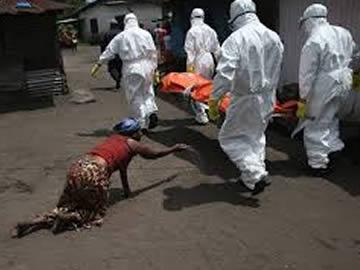Treatment Of Ebola

TREATMENT
Approach to therapy — Whenever possible, patients with Ebola virus disease should receive care in designated treatment centers and by clinicians trained to care for such patients [5]. Treating patients with Ebola requires a multidisciplinary approach [6]. All healthcare workers involved in the care of infected or potentially infected patients should use infection control precautions, including the proper use of personal protective equipment. (See 'Infection control precautions' below.)
The mainstay of treatment for Ebola virus disease involves supportive care to maintain adequate cardiovascular function while the immune system mobilizes an adaptive response to eliminate the infection [1,7-13]. (See 'Supportive care' below.)
In addition, several experimental antiviral therapies have been used in patients with Ebola virus disease during the 2014-2015 outbreak in West Africa. The efficacy of these agents is unclear and is an active area of investigation. In addition, the availability of these drugs is limited. Thus, decisions about whether or not to use antiviral therapy, the choice of antiviral therapy, and the timing of administration of antiviral therapy should be made in conjunction with public health officials. (See 'Antiviral therapy' below.)
Supportive care — The most important aspects of supportive care involve preventing intravascular volume depletion, correcting profound electrolyte abnormalities, and avoiding the complications of shock (see "Treatment of severe hypovolemia or hypovolemic shock in adults"). Lessons learned from the care of patients with Ebola virus disease during the West African outbreak include [9-16]:
●Patients may lose large amounts of fluid through vomiting and diarrhea, requiring rapid volume replacement to prevent shock; antiemetic and antidiarrheal agents may also be beneficial [11,13,17]. Careful attention to the volume of fluid losses and intake will assist with fluid repletion targets.
●When available, patients will benefit from hemodynamic monitoring and intravenous fluid repletion [13,15]. However, patients in the early phase of illness, who respond to oral anti-emetic and anti-diarrheal therapy, may be able to take in sufficient fluids by mouth to prevent or correct dehydration [13].
●Patients may develop significant electrolyte disturbances (eg, hyponatremia, hypokalemia, hypomagnesemia, and hypocalcemia) and may require frequent repletion of electrolytes to prevent cardiac arrhythmias. (See "Overview of the treatment of hyponatremia in adults" and "Treatment of hypocalcemia" and "Evaluation and treatment of hypophosphatemia" and "Evaluation and treatment of hypomagnesemia".)
●Intensive nursing may be required in order to respond to the patient's changing clinical situation.
Fluid and electrolyte replacement — Fluid and electrolyte replacement can be administered orally or intravenously depending, in part, upon the stage of illness and the clinical presentation. As an example, in resource-limited settings, oral therapy to prevent or correct dehydration may be suitable for patients in the early phase of illness who respond to oral anti-emetic and anti-diarrheal therapy [13]. However, patients in shock, and those who are unable to tolerate or manage self-directed oral replacement therapy, will require intravenous fluids.
The approach to fluid and electrolyte replacement will also depend upon the availability of resources [18]:
●In some areas, resources such as monitoring and laboratory capacity are very limited. In these settings, patients who experience fluid losses from vomiting and diarrhea may require five or more liters per day of a balanced crystalloid solution (eg, 0.9% sodium chloride solution supplemented with potassium, or lactated Ringers solution). Qualitative assessments of urine frequency, volume, and color, as well as evaluation of skin turgor and mucous membranes, may assist in guiding volume replacement in the absence of more accurate measures. (See "Etiology, clinical manifestations, and diagnosis of volume depletion in adults", section on 'Clinical manifestations'.)
●In areas with greater resources, careful attention to the volume of fluid losses and intake, as well as indirect assessments of intravascular volume status (eg, vascular ultrasound, indwelling catheters for central venous pressure monitoring), will assist with fluid repletion targets. Electrolyte replacement should be guided by plasma values. (See "Treatment of severe hypovolemia or hypovolemic shock in adults".)
●In resource-rich areas, clinicians may employ standard supportive measures for critically ill patients in shock, including invasive blood pressure and continuous pulse-oximetry monitoring. Hypotension may sometimes persist despite adequate volume resuscitation, requiring the use of vasopressor infusions such as norepinephrine. Aggressive volume resuscitation may contribute to the development of pulmonary edema, and acute lung injury in the setting of shock may necessitate supplemental oxygen therapy (eg, nasal cannula or face mask). (See "Evaluation and management of severe sepsis and septic shock in adults".)
Respiratory support — Invasive mechanical ventilation (intubation) may be the best option for patients with progressive respiratory failure [19,20]. When considering the management of such patients with Ebola virus disease, clinicians should recognize that some types of respiratory support present a hazard of generating infectious aerosols. The use of non-invasive mechanical ventilation or high-flow oxygen therapy (eg, Vapotherm) is generally not recommended given the potential for continuous aerosol production. (See "Continuous oxygen delivery systems for infants, children, and adults".)








